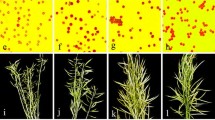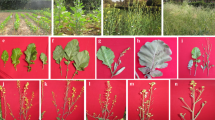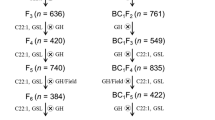Abstract
Brassica napus L is an important oilseed crops grown throughout many parts of the world. It is well adapted to long day photoperiods. Synthetic B. napus was produced through interspecific hybridization between B. rapa L. var Tori-7 and exotic variety of B. oleracea L. var. alboglabra Bailey. The chromosomes of the interspecific hybrids were doubled through the treatments of colchicine. Synthetic B. napus had increased growth and exhibited wider range of variations than parents for plant height leaf and floral characters, siliquae related characters, flowering and maturity characters, yield and yield contributing characters and sterility and siliquae shattering characters. Resynthesized lines (RS) showed higher plant height, leaf width compare to check variety BINA Sarisha-04. The RS lines also found to be best for siliquae related characters (siliquae length, break length, length of main fruiting axis, siliquae density siliquae angle). On the basis of flowering and maturity characters (1st, 50% and 90% flowering and days to maturity) RS lines showed six days earlier than check variety but not early maturing B. rapa parent Tori-7. The RS lines found to be promising for yield, yield contributing characters and oil content (primary and secondary branches per plant, siliquae per plant, seeds per plant, 1000 seeds weight, seed yield per plant and oil content). On the basis of sterility and shattering characters (pollen sterility %, siliquae setting, sterile seeds per siliquae, siliquae shattered at harvest and siliquae shattered after 7 days of harvest) the RS lines were better performer than check variety. The developed RS lines may be useful for rapeseed breeding to improve earliness, shattering tolerance and higher yield.





Similar content being viewed by others
Data availability
Department of Genetics and Plant Breeding, Bangladesh Agricultural University, Mymensingh-2202, Bangladesh.
References
Abel S, Möllers C, Hecker HC (2005) Development of synthetic Brassica napus lines for the analysis of “fixed heterosis” in allopolyploid plants. Euphy 146:157–163
Akbar MA (1987) Resynthesis of B. napus for earliness and day length insensitivity. PhD Thesis, Department of Plant Breeding, Swedish University of Agricultural Science, Uppsala, Sweden
Akbar MA (1989) Resynthesis of Brassica napus aiming for improved earliness and carried out by different approaches. Hered 111:239–246
Becker HC, Engqvist GM, Karlsson B (1995) Comparison of rapeseed cultivars and resynthesized lines based on allozyme and RFLP markers. Theor and Appl Gent 91:62–67
Chatterjee D, Banga S, Gupta M, Bharti S, Salisbury PA, Banga SS (2016) Resynthesis of Brassica napus through hybridization between B. juncea and B. carinata. Theore and Appl Genet 129(5):977–990
FAOSTAT. 2018/2018. http://www.faostat3.fao.org
Folch J, Lees M, Stanley GHS (1957) A simple method for the isolation and purification of total lipides from animal tissues. J Biol Chem 226:497–509
Girke A, Schierholt A, Becker HC (2011) Extending the rapeseed genepool with resynthesized Brassica napus L. I: genetic diversity. Genet Resour Crop Evol 59:1441–1447
Heath DW, Elizabeth DE (1997) Synthesis of low linolenic acid rapeseed (Brassica napus L.) through protoplast fusion. Euphyt 93:339–343
Jesske T, Olberg B, Schierholt A, Becker HC (2013) Resynthesized lines from domesticated and wild Brassica taxa and their hybrids with B. napus L.: genetic diversity and hybrid yield. Theor Appl Genet 126:1053–1065
Jourdan PS, Earle ED, Mutshler MA (1989) Atrazine resistant cauliflower obtained by somatic hybridization between Brassica oleracea and ATR B. napus. Theo Appl Genet 78:271–279
Karim M, Siddika A, Tonu N, Hossain DM, Meah B (2014) Production of high yield short duration Brassica napus by interspecific hybridization between B. oleracea and B. rapa. Breed Sci 63:495–502
Kräling K (1987) Utilization of genetic variability of resynthesized rapeseed. Plant Breed 99:209–217
Leitch L, Bennett M (1997) Ployploidy and novelty in flowering plants. Am Natiralist 122(1):470–476
Lu CM, Zhang B, Kakihara F, Kato M (2004a) Introgression of genes into cultivated Brassica napus through resynthesis of B. napus via ovule culture and the accompanying change in fatty acid composition. Plant Breed 120(5):405–410
Lu CM, Zhang B, Liu L, Kato M (2004b) Genetic analysis of petal size through genomic manipulation in Brassica. Plant Breed 123(5):495–496
Malek MA, Ismail MR, Rafii MY, Rahman M (2012) Synthetic Brassica napus L. development and studies on morphological characters, yield attributes, and yield. Sci World J 2012:1–6
Meng J, Shi S, Gan L, Li Z, Qu X (1998) The production of yellow-seeded Brassica napus (AACC) through crossing interspecific hybrids of B. campestris (AA) and B. carinata (BBCC) with B napus. Euphyt 103(3):329–333
Mortuza MG, Dutta PC, Das ML (2006) Erucic acid content in some rapeseed/mustard cultivars developed in Bangladesh. J Sci Food Agric 56:135–139
Namai H, Sarashima M, Hosoda T (1980) Interspecies and Intergeneric hybridization breeding in Japan. In: Brassica crops and wild allies, biology and breeding, Jpn Sci Soc Press, Tokyo, pp 191–203
Rahman MH (2001) Production of yellow seeded Brassica napus through interspecific crosses. Plant Breed 120:463–472
Rahman MH (2004) Resynthesis of Brassica napus for self-incompatibility: self-incompatibility reaction, inheritance and breeding potential. Plant Breed 124:13–19
Rahman MH, Bennett RA, Yang RC, Kebede B, Mohan RT (2011) Exploitation of the late flowering species Brassica oleracea L. for the improvement of earliness in B. napus L.: an untraditional approach. Euphyt 177:365–374
Schranz ME, Osborn TC (2000) Novel flowering time variation in the resynthesized polyploid Brassica napus. J Hered 91(3):242–246
Seyis F, Friedt W, Luhs W (2010) Yield of B. napus L. hybrids developed using resynthesised rapeseed material. Anodolu J Agril Sci 25(3): 159–167
Shiga T (1970) Rape breeding by interspecific crossing between Brassica napus and Brassica campestris in Japan. Jpn Agric Res Q 5:5–10
Song K, Lu P, Tang K, Osborn TC (1995) Rapid genome change in synthetic polyploids of Brassica and its implications for polyploid evolution. Proc Nat Acad Sci USA 92:7719–7723
Tsunoda S (1980) Eco-physiology of wild and cultivated forms in Brassica and allied genera. In: Brassica crops wild allies, Jpn. Sci. Soc. Press, Tokyo, pp 109–119
Wright RJ, Taxon PM, El-Zik KM, Paterson AH (1998) D-subgenome bias on Xcm resistance genes in tetraploid Gossypium (coton) suggests that polyploid formation has created navel avenues for evolution. Genetics 149:1987–1996
Yingze N, Liangzhong W, Yuzhen L (2003) Creation of new germplasm in B. napus using landraces of B. chinensis and B. oleracea var. alboglabra from SW China. In: Australian agronomy conference, pp 25–30
Zaman MW (1989) Introgression in Brassica napus for adaptation to the growing conditions in Bangladesh. Theor Appl Genet 77(5):721–728
Zou J, Zhu J, Huang S, Tian E, Xiao Y, Fu D, Tu J, Fu T, Meng J (2010) Broadening the avenue of intersubgenomic heterosis in oilseed Brassica. Theor Appl Genet 120:283–290
Acknowledgements
Bangladesh Agricultural Research Institute (BARI) and Bangladesh Institute of Nuclear Agriculture (BINA) for providing necessary research facilities. Department of Agricultural Extension, Ministry of Agriculture for awarding scholarship to Gour Gobindo das and research grants.
Author information
Authors and Affiliations
Contributions
AKMS; design, formulation, supervision of experiment and writing of manuscript. GGD; design, performing experiments, collection and analysis of data, writing of manuscript. MAM; supervision of experiments and review of manuscript. GHMS; supervision, data analysis, writing of manuscript.
Corresponding author
Ethics declarations
Conflict of interest
The authors have declared that no competing interests exist.
Additional information
Publisher's Note
Springer Nature remains neutral with regard to jurisdictional claims in published maps and institutional affiliations.
Rights and permissions
About this article
Cite this article
Das, G.G., Malek, M.A., Shamsuddin, A.K.M. et al. Development of high yielding early matured and shattering tolerant Brassica napus L. through interspecific hybridization between B. rapa L. and B. oleracea L.. Genet Resour Crop Evol 69, 1009–1018 (2022). https://doi.org/10.1007/s10722-021-01277-3
Received:
Accepted:
Published:
Issue Date:
DOI: https://doi.org/10.1007/s10722-021-01277-3




